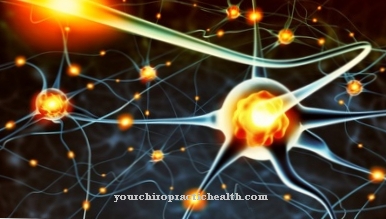The divergence is a circuit of the central nervous system that is relevant for the sharpness of perceptions. Each receptor is divergingly connected to neurons in higher levels and at the same time hangs convergingly to lower neurons. Disturbances of the divergence-convergence principle can occur after nerve damage.
What is the divergence?

The individual levels of information processing in the human central nervous system are subject to different switching principles. The most important of these principles are convergence and divergence. The two circuits result in the formation of a contrast by lateral inhibition. The human sense organs are equipped with sensory cells, also known as receptors. Each of these receptors corresponds to a line of information that leads to the thalamus via several levels of neurons. The thalamus has a connection to the cerebrum, where the sensory impressions are finally processed.
Instead of a one-to-one connection, there is a diverging connection between the levels of neurons. For example, each neuronal cell is connected to several neurons of the higher layers. This principle corresponds to divergence. The reception of signals by receptors and neurons in underlying layers is called convergence.
The convergence-divergence principle leads to a lateral inhibition in which the downstream neurons each cause a signal reduction in the neighboring cells. The resulting stimulation image shows the intensity pattern of the incoming stimuli in a differentiated way, as the individual transitions are strengthened and contrasted in the conscious perception.
Function & task
In mammals, the principle of convergence and divergence characterizes both the processing of primary sensory data of the retina, the cochlea and the skin senses, as well as the connection between the thalamus, the cerebrum and the cerebellum. Through divergence and convergence, all diffuse stimuli from the environment immediately take on a distinct, differentiated form. In this way, the stimulus data are immediately structured holistically and closed.
The nervous system does this structuring automatically. Thanks to divergence and convergence, the visual system automatically provides images with sharp contours, for example. The human cerebrum already receives structured information from the receptors of the individual sensory systems and their receptors on the basis of convergence and divergence. The perception information that is passed on deviates significantly from reality.
From an evolutionary point of view, divergence and the structured perceptual information are important because they enable the organism to react more easily to the environment.
Due to the falsification by convergence-divergence principles, humans can for example recognize individual pitches from an auditory input or recognize instruments even though they sound together. Thanks to the lateral inhibition, the visual system can, for example, identify figures in motion as a result of divergence and convergence, and the gustatory system recognizes different types of food based on a single bite or sip.
Lateral inhibition through divergence and convergence is a subconscious process that in most cases goes unnoticed. However, optical illusions, for example, make use of the divergence-convergence principle and in this way confront people directly with the phenomenon of lateral inhibition. In this way he consciously notices how much the basic principles of perception alienate the reality around him.
You can find your medication here
➔ Medicines for visual disturbances and eye complaintsIllnesses & ailments
In the event of damage to neural structures, the divergence principle of perception can be disturbed. Neuronal damage can be traced back to various connections. For example, various neurological diseases can be the cause of lesions in the central nervous system.
In diseases such as multiple sclerosis, for example, the patient's immune system causes inflammation in the nerve tissue of the central nervous system and can thus permanently damage the central nervous structures. Neuronal cells are then no longer connected to several neurons in the higher layers when the higher-lying nerve cells are damaged. Such a phenomenon amounts to a disturbance of the divergence principle. If in turn the divergence principle is disturbed, the lateral inhibition by divergence and convergence is also disturbed.
In the visual system, the lateral inhibition plays a role in particular for the quality of sensory impressions at dusk. Damage to the retinal transverse neurons, for example, can complicate difficulties in the summation of individual stimuli of a receptive field in the case of dark adaptation and the lateral inhibition in the case of light adaptation. The consequence is complaints in twilight vision. The patient's visual perception is also difficult in extreme brightness. Such complaints can be present, for example, in the context of diabetic retinopathy or go back to an X-linked night blindness.
The divergence principle also plays a decisive role in the sense of skin. For this reason, disturbances of the divergence due to nerve damage can also affect this area of perception and thus reduce the tactile acuity in the haptic and tactile area.
With any disturbance of lateral inhibition, the spread of excitation in the central nervous system is no longer spatially limited, which can result in over-excitability of the nervous system. The brain no longer receives clearly structured information from the sensory systems from an overexcited nervous system with reduced lateral inhibition.
With all complaints related to the divergence of the nervous system, the contrasting of the perceptions is reduced or even eliminated, so that it is more difficult for people to recognize and interpret the sensory impressions.












.jpg)



.jpg)










.jpg)
